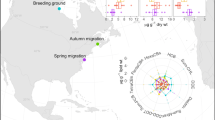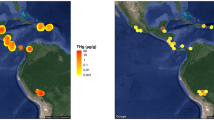Abstract
The Contaminant Exposure and Effects—Terrestrial Vertebrates (CEE-TV) database was developed to conduct simple searches for ecotoxicological information, examine exposure trends, and identify significant data gaps. The CEE-TV database contains 16,696 data records on free-ranging amphibians, reptiles, birds, and mammals residing in estuarine and coastal habitats of the Atlantic, Gulf, and Pacific coasts, Alaska, Hawaii, and the Great Lakes. Information in the database was derived from over 1800 source documents, representing 483 unique species (about 252,000 individuals), with sample collection dates spanning from 1884 to 2003. The majority of the records contain exposure data (generally contaminant concentrations) on a limited number (n = 209) of chlorinated and brominated compounds, cholinesterase-inhibiting pesticides, economic poisons, metals, and petroleum hydrocarbons, whereas only 9.3% of the records contain biomarker or bioindicator effects data. Temporal examination of exposure data provides evidence of declining concentrations of certain organochlorine pesticides in some avian species (e.g., ospreys, Pandion haliaetus), and an apparent increase in the detection and possibly the incidence of avian die-offs related to cholinesterase-inhibiting pesticides. To identify spatial data gaps, 11,360 database records with specific sampling locations were combined with the boundaries of coastal watersheds, and National Wildlife Refuge and National Park units. Terrestrial vertebrate ecotoxicological data were lacking in 41.9% of 464 coastal watersheds in the continental United States. Recent (1990–2003) terrestrial vertebrate contaminant exposure or effects data were available for only about half of the National Wildlife Refuge and National Park units in the geographic area encompassed by the database. When these data gaps were overlaid on watersheds exhibiting serious water quality problems and/or high vulnerability to pollution, 72 coastal watersheds, and 76 National Wildlife Refuge and 59 National Park units in the continental United States were found to lack recent terrestrial vertebrate ecotoxicology data. Delineation of data gaps in watersheds of concern can help prioritize monitoring in areas with impaired water quality and emphasize the need for comprehensive monitoring to gain a more complete understanding of coastal ecosystem health.

Similar content being viewed by others
References
BEST (Biomonitoring of Environmental Status and Trends Program) (2003) http://www.best.usgs.gov
Breckenridge RP, Manguba M, Anderson PJ, Bartish TM (2003) Using biomonitoring data for stewardship of natural resources. In: Hoffman DJ, Rattner BA, Burton GA Jr, Cairns J Jr (eds). Handbook of ecotoxicology, 2nd edition. Lewis Publishers, Boca Raton, Florida, pp 233–255
Cohen JB, Rattner BA, Golden NH (2003) Use of retrospective data to assess ecotoxicological monitoring needs for terrestrial vertebrates residing in Atlantic coast estuaries. Ecotoxicology 12:365–375
Eisler R (2000) Handbook of chemical risk assessment: Health hazards to humans, plants, and animals. Volume 1. Metals. Lewis Publishers, Boca Raton, Florida, pp 313–409
Evers DC, Kaplan JD, Meyer MW, Reaman PS, Braselton WE, Major A, Burgess N, Scheuhammer AM (1998) Geographic trend in mercury measured in common loon feathers and blood. Eviron Toxicol Chem 17:173–183
Fleischli MA, Franson JC, Thomas NJ, Finley DL, Riley W Jr (2004) Avian mortality events in the United States caused by anticholinesterase pesticides: A retrospective summary of National Wildlife Health Center records from 1980 to 2000. Arch Environ Contam Toxicol 46:542–550
Golden NH, Rattner BA (2003) Ranking terrestrial vertebrate species for utility in biomonitoring and vulnerability to environmental contaminants. Rev Environ Contam Toxicol 176:67–136
Hale RC, La Guardia MJ (2002) Emerging contaminants of concern in coastal and estuarine environments. In: Newman MC, Roberts MH Jr, Hale RC (eds). Coastal and estuarine risk assessment. Lewis Publishers, Boca Raton, Florida, pp 41–72
Kolpin DW, Furlong ET, Meyer MT, Thurman EM, Zaugg SD, Barber LB, Buxton HT (2002) Pharmaceuticals, hormones, and other organic wastewater contaminants in U.S. streams, 1999–2000: A national reconnaissance. Environ Sci Technol 36:1202–1211
NRC (National Research Council) (1995) A review of the Biomonitoring of Environmental Status and Trends program: The draft detailed plan. National Research Council. National Academy Press, Washington, DC, 74 pp
Rattner BA, Pearson JL, Golden NH, Cohen JB, Erwin RM, Ottinger MA (2000) Contaminant exposure and effects—Terrestrial vertebrates database: trends and data gaps for Atlantic Coast estuaries. Environ Monit Assess 63:131–142
Russom CL (2002) Mining environmental toxicology information: Web resources. Toxicology 173:75–88
Schmitt CJ, Bunck CM (1995) Persistent environmental contaminants in fish and wildlife. In: LaRoe ET, Farris GS, Puckett CE, Doran PD, Mac MJ (eds). Our living resources. U.S. Department of the Interior, Nature Biology Service, Washington, DC, pp 413–416
Sparling DW, Bishop CA, Linder G (2000) The current status of amphibian and reptile ecotoxicological research. In: Sparling DW, Bishop CA, Linder G (eds). Ecotoxicology of amphibians and reptiles. SETAC Press, Pensacola, Florida, pp 1–13
US EPA (U.S. Environmental Protection Agency) (1997a) The index of watershed indicators. EPA-841-R-97-010. United States Environmental Protection Agency, Office of Water, Washington, DC
US EPA (U.S. Environmental Protection Agency) (1997b) Mercury study report to Congress, Vol. 2. An inventory of anthropogenic mercury emissions in the United States. EPA-452/R-97-004. United States Environmental Protection Agency, Office of Air Quality Planning & Standards and Office of Research and Development, Washington, DC
US EPA (U.S. Environmental Protection Agency) (2000) Environmental Monitoring and Assessment Home Page (EMAP). World Wide Web site, http://www.epa.gov/emap
Walker JD (2003) QSARs for toxicity screening—current practices. In: Walker JD (eds). Quantitative structure–activity relationships for pollution prevention, toxicity screening, risk assessment, and Web applications. SETAC Press, Pensacola, Florida, pp 39–74
Zylstra SJ (1994) A new program for biomonitoring status and trends in the environment. J Aquat Ecosyst Health 3:81–85
Acknowledgments
We thank Lynda J. Garret, Wanda Manning, and Kathryn A. Mannstedt for assistance with the computerized literature searches and data retrieval; Craig R. Beckman, Eileen K. Henniger, Rebecca L. Kershnar, Elise A. Larsen, Katie L. Lobner, Anne M. Meckstroth, and Craig W. Meeusen for compiling and coding database records; and Jonathan B. Cohen and James J. Coyle for reviewing a draft of this manuscript.
Author information
Authors and Affiliations
Corresponding author
Rights and permissions
About this article
Cite this article
Rattner, B.A., Eisenreich, K.M., Golden, N.H. et al. Retrospective Ecotoxicological Data and Current Information Needs for Terrestrial Vertebrates Residing in Coastal Habitat of the United States. Arch Environ Contam Toxicol 49, 257–265 (2005). https://doi.org/10.1007/s00244-004-0193-y
Received:
Accepted:
Published:
Issue Date:
DOI: https://doi.org/10.1007/s00244-004-0193-y




